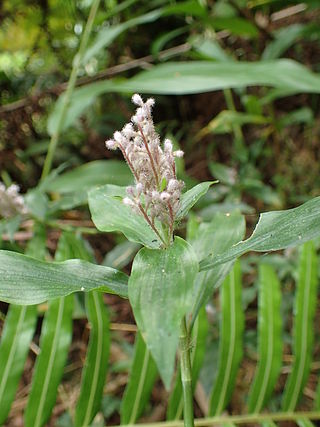
Commelinaceae is a family of flowering plants. In less formal contexts, the group is referred to as the dayflower family or spiderwort family. It is one of five families in the order Commelinales and by far the largest of these with about 731 known species in 41 genera. Well known genera include Commelina (dayflowers) and Tradescantia (spiderworts). The family is diverse in both the Old World tropics and the New World tropics, with some genera present in both. The variation in morphology, especially that of the flower and inflorescence, is considered to be exceptionally high amongst the angiosperms.

Dichorisandra is a genus of perennial monocotyledonous flowering plants in the dayflower family (Commelinaceae). It is found in the Neotropics. The genus is characterised by its slightly zygomorphic flowers with large anthers usually releasing pollen by means of pores at the apex, as well as by its seeds that are embedded in a red or sometimes white aril, and tubers that often form at the tips of the roots. Both morphology and an analysis of DNA sequences indicate it is very closely related to the genus Siderasis.

Cyanotis is a genus of mainly perennial plants in the family Commelinaceae, first described in 1825. It is native to Africa, southern Asia, and northern Australia.

Cochlospermum is a genus of trees in the Bixaceae family; some classifications place this genus in the family Cochlospermaceae. It is native to tropical regions of the world, particularly Latin America, Africa, the Indian Subcontinent, and Australia.

Aneilema is a genus of monocotyledonous plants of approximately 60 species. The vast majority of the species are native to sub-Saharan Africa, but a few are found in Oceania and one, Aneilema brasiliense, is from South America. It is the third largest genus in the family Commelinaceae after Commelina and Tradescantia, and it is one of only six genera in the family to occur in both the Eastern Hemisphere and the Western Hemisphere.

Floscopa is a genus of plants in the family Commelinaceae first described in 1790. It is widespread in tropical and subtropical areas: Africa, Madagascar, the Indian Subcontinent, Southeast Asia, China, Queensland, Central + South America.

Palisota is a genus of plant in family Commelinaceae, first described in 1828. It is native to sub-Saharan Africa.
Tricarpelema is a genus of monocotyledonous flowering plants in the family Commelinaceae consisting of 8 species. The genus is divided into two subgenera, subgenus Tricarpelema, which includes 7 known species found in tropical Asia, and subgenus Keatingia with one species in western Africa. The Asian species are typically found in the forest understory while the single African species has evolved to drier, sunnier conditions and is usually associated with inselbergs.

Cartonema is a genus of perennial or annual monocotyledonous flowering plants in the dayflower family. It is restricted to Australia and nearby Trangan Island, which is part of Indonesia. It is the earliest diverging member of its family and has a number of traits that are unique within it, such as non-succulent leaves and a lack of raphides. Its distinctive features led to the genus to once be considered part of its own separate family, Cartonemataceae. However, analysis of DNA sequences, as well as many common anatomical characters, has supported its relationship with the Commelinaceae. It contains about 11 species.

Triceratella is a genus of annual monocotyledonous flowering plants in the dayflower family. The genus consists of a single species, Triceratella drummondii. It is known to occur in Zimbabwe and Mozambique, but has only been collected twice. Because of its rarity, DNA sequences have never been used to determine its relatives, but it is believed to be closely related to the early diverging genus Cartonema, with which it shares a number of characters unique for the dayflower family, such as a yellow flowers, glandular hairs, and a lack of glandular microhairs. It differs from Cartonema, however, in having raphides, which all other members of the Commelinaceae have, although they occur in a unique position next to the leaf veins in Triceratella.

Murdannia is a genus of annual or perennial monocotyledonous flowering plants in the family Commelinaceae.

Buforrestia is a genus of perennial monocotyledonous flowering plants in the dayflower family. The genus contains three known species, with two found in West and Central Africa and one in northeastern South America.

Coleotrype is a genus of perennial monocotyledonous flowering plants in the dayflower family. It is found in Africa and Madagascar.

Amischotolype is a genus of perennial monocotyledonous flowering plants in the Commelinaceae. It is found in Central Africa and from India through Southeast Asia to New Guinea, with the great majority or species found in Asia.

Commelineae is a tribe of monocotyledonous flowering plants in the dayflower family (Commelinaceae). The tribe consists of 13 genera and about 350 species. It is one of two tribes in the subfamily Commelinoideae, the other being the Tradescantieae, which is made up of 26 genera and about 300 species. The remaining two genera in the family are in a separate subfamily, the Cartonematoideae.
Murdannia sepalosa is a species of flowering plant in the family Commelinaceae. It is a tuberous perennial geophyte native to central and eastern Africa.

Commelina africana, the common yellow commelina, is a widespread species of flowering plant in the family Commelinaceae. It is native to Sub‑Saharan Africa, Madagascar, Réunion, and the Arabian Peninsula, and has been introduced to India. It is occasionally consumed as a leaf vegetable, and occasionally fed to rabbits and pigs.














